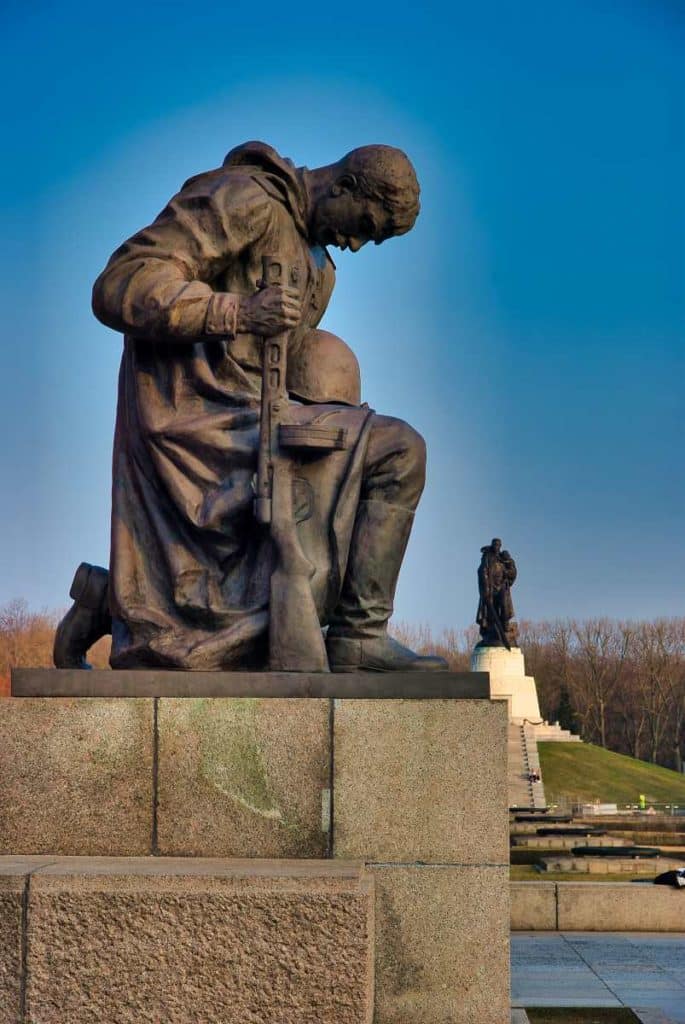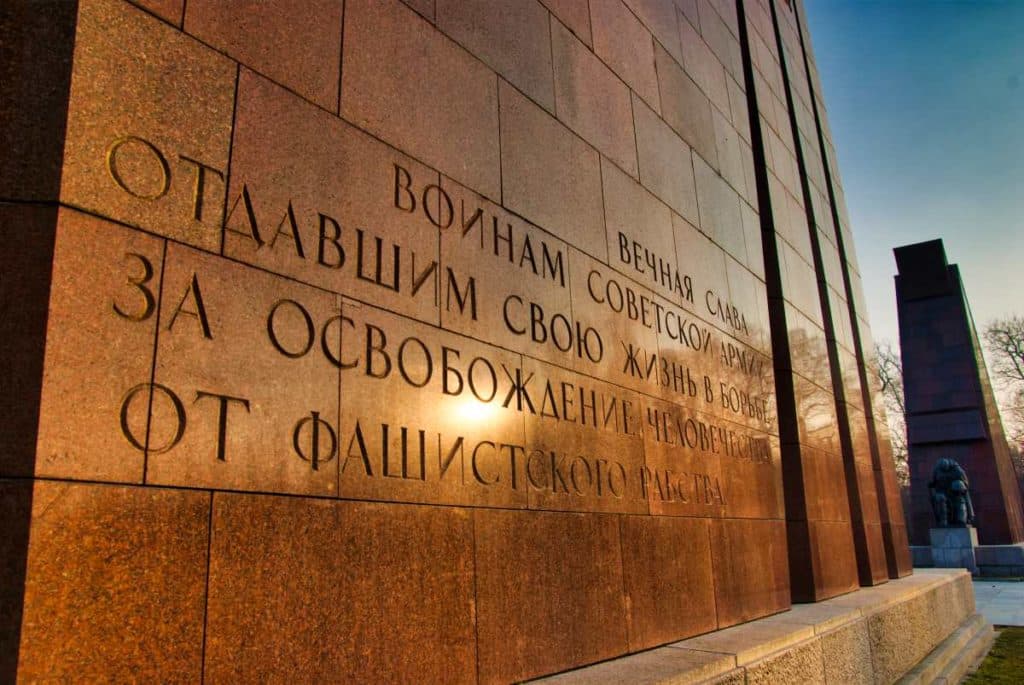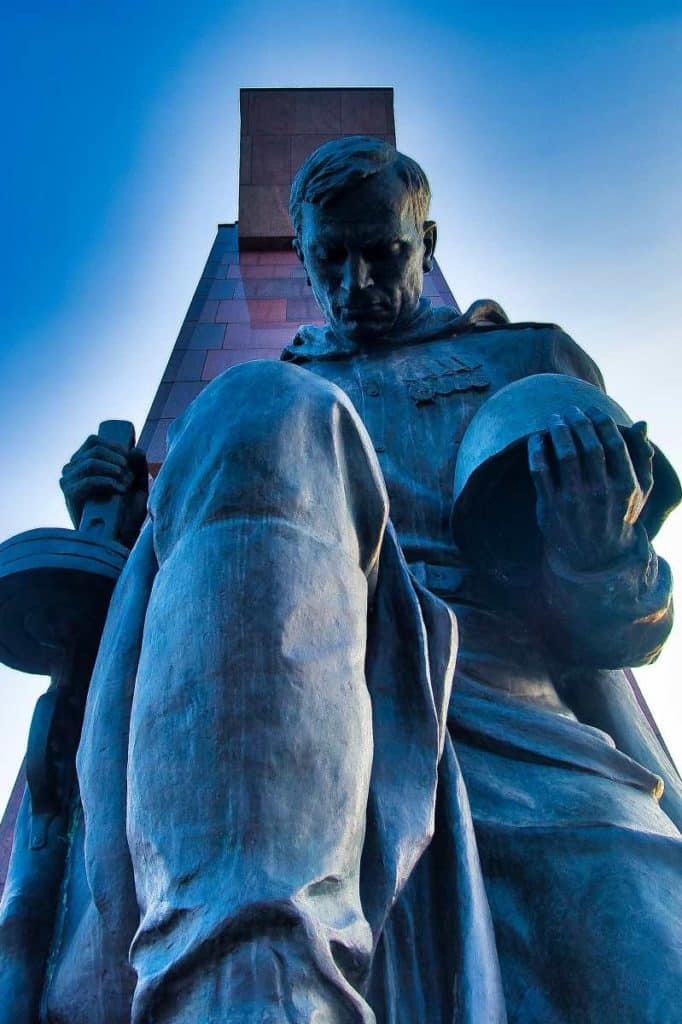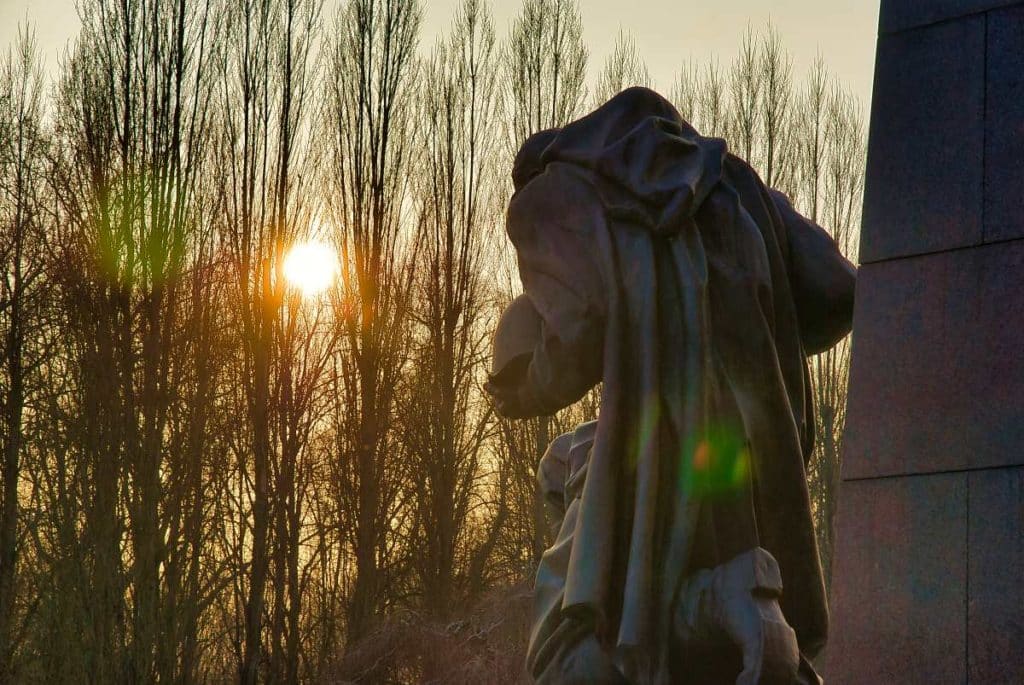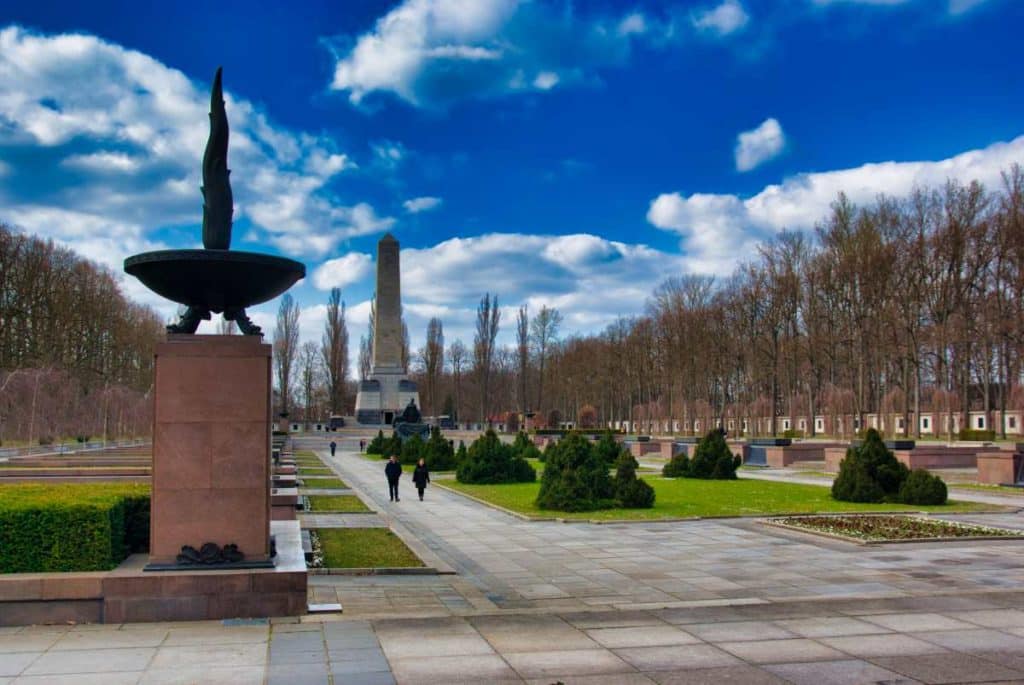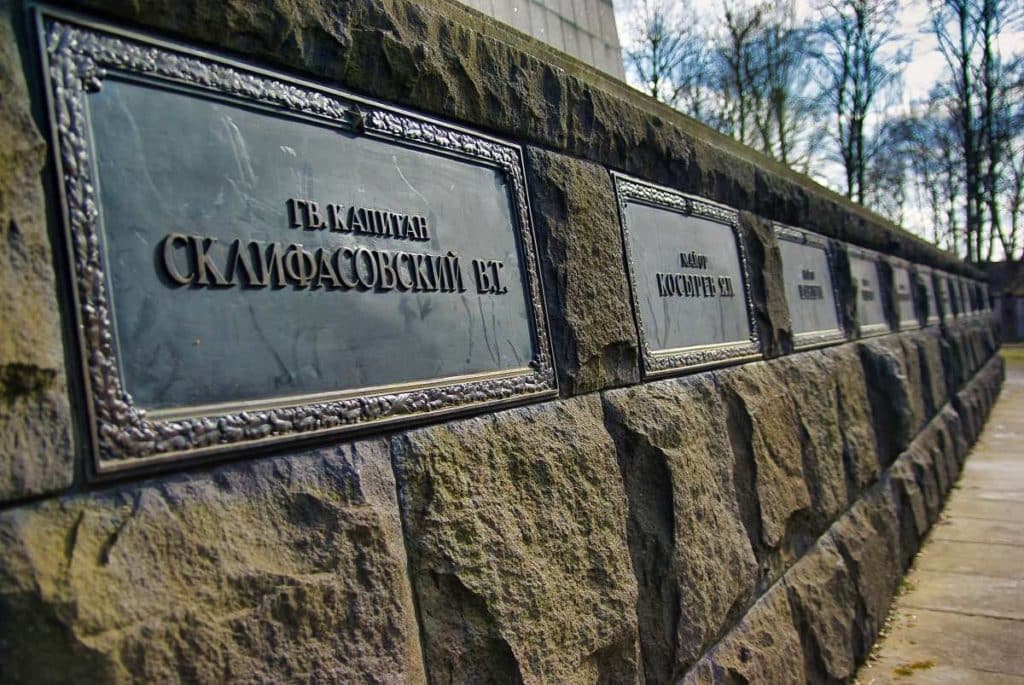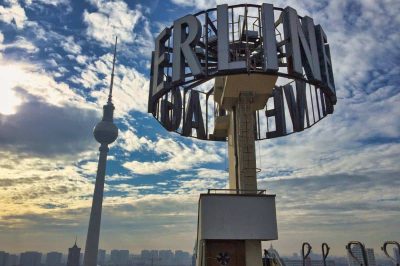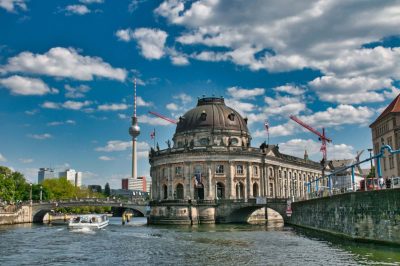The meteorologists predicted spring-like 18 degrees and sunshine for April 16, 1945 in Berlin. What they did not predict was an artillery storm that rained down from over 40,000 guns on the western side of the Oder at 3 a.m. sharp: the starting signal from the Red Army for the final offensive of the Second World War on European soil. The aim was to conquer the “den of the fascist beast” – Berlin. 17 days later, on May 2, 1945, the last defenders of the Reich capital surrendered. But the blood toll was exorbitant, on both sides. While an estimated 100,000 soldiers and civilians lost their lives on the German side, the Soviet army suffered over 80,000 casualties. And the dead had to be buried appropriately.
Just a few days after the German capitulation, the Soviet side was already looking for suitable locations and drawing up plans. In addition to various smaller cemeteries, three monumental memorials were built in the second half of the 1940s, where thousands of Red Army soldiers were buried: in the centrally located Tiergarten, in Treptower Park and in Schönholzer Heide in the north of Berlin. In this article, we want to introduce you to the Soviet memorials in Berlin, but first explain why they are still standing in Berlin today.
The two-plus-four treaty and the memorials
Paragraph 2 of the Two-Plus-Four Treaty (1990), which legally established the unification of the FRG and the GDR into one Germany, contains a passage that was extremely important to the Soviets withdrawing from the GDR:
Monuments erected on German soil and dedicated to the victims of war and tyranny are respected and protected by German law. The same applies to the war graves, which are preserved and maintained.
In the war graves agreement signed between Germany and Russia two years later, this pledge was emphasized once again, along with other agreements. For this reason, the Federal Republic of Germany is also obliged to guarantee and finance the maintenance, preservation and possible renovations in the future.
The Soviet memorial in the Tiergarten
Construction work on the cemetery in Tiergarten began in the early summer of 1945. The location is absolutely central in Berlin, just a few meters away from the Brandenburg Gate and the Reichstag building. If the Nazis had been able to realize their plans for the new Reich capital “Germania”, the brutal north-south axis would have run along this site. The Red Army mourns and honors its fallen at the very place where monstrous parades of the victorious Wehrmacht should have taken place. The irony of history rarely manifests itself more symbolically.
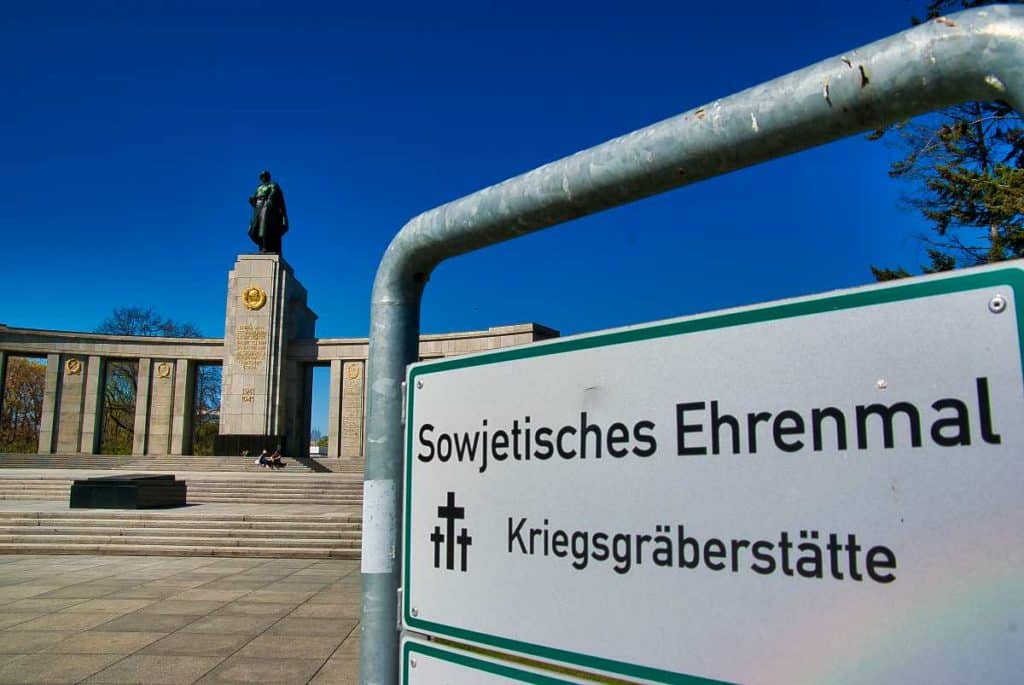
The memorial was completed just in time for November 7, 1945, the anniversary of the October Revolution, and was ceremoniously opened a few days later with a military parade in which French, British and US troop contingents also took part. In the center of the memorial, an eight-meter tall Red Army soldier, designed by the sculptors Lew Kerbel and Wladimir Zigal, is enthroned on a mighty pedestal. The soldier’s shouldered carbine indicates the end of the fighting, while his left hand rests protectively over his fallen comrade. The Cyrillic inscription on the plinth reads
“Eternal glory to the heroes who fell for the freedom and independence of the Soviet Union in the fight against the fascist German invaders. 1941-1945”.
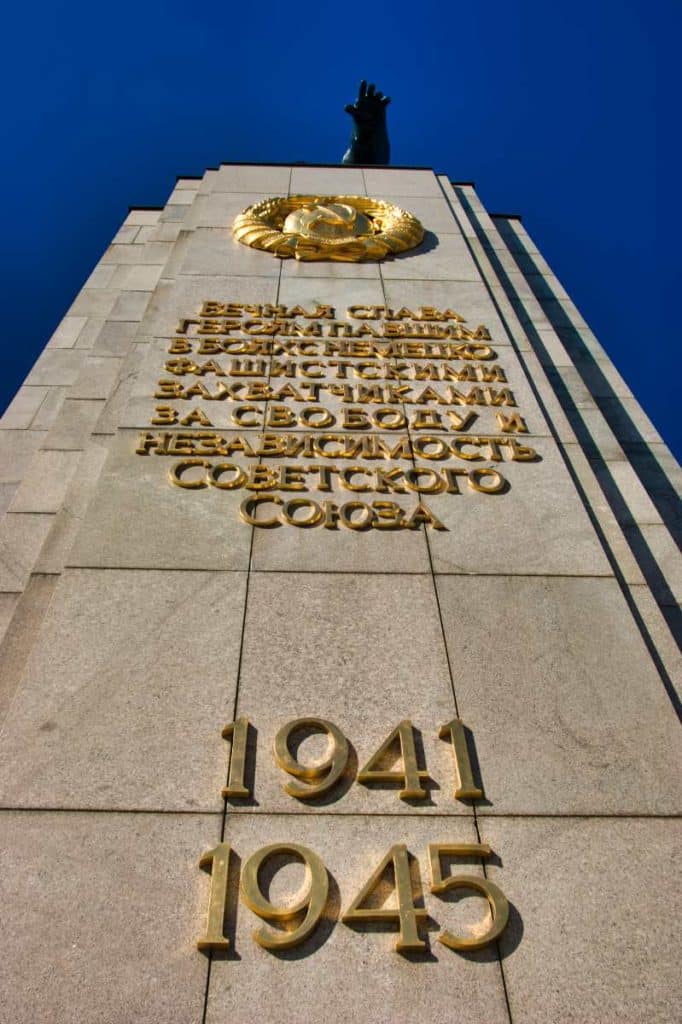
The names of fallen soldiers are immortalized in the concave colonnades that adjoin the statue of the Red Army soldier on both sides. Two heavy artillery pieces and two T34/76 tanks are symmetrically arranged in front of the actual memorial. According to the official Soviet legend, the two armored vehicles were the first to cross the Berlin city limits.
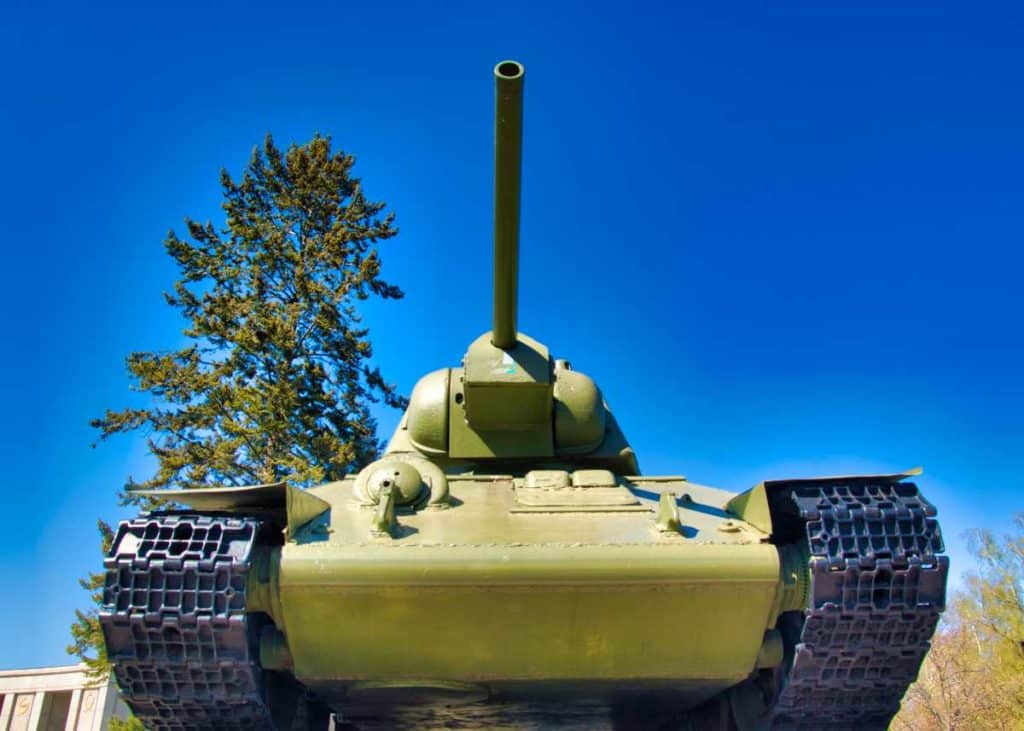
Behind the colonnades you will find information about the history and historical background in the former buildings of the guard soldiers. Only behind it is an extensive lawn under which over 2000 Red Army soldiers found their final resting place. However, as only a few of them were known by name, no gravestones were erected.
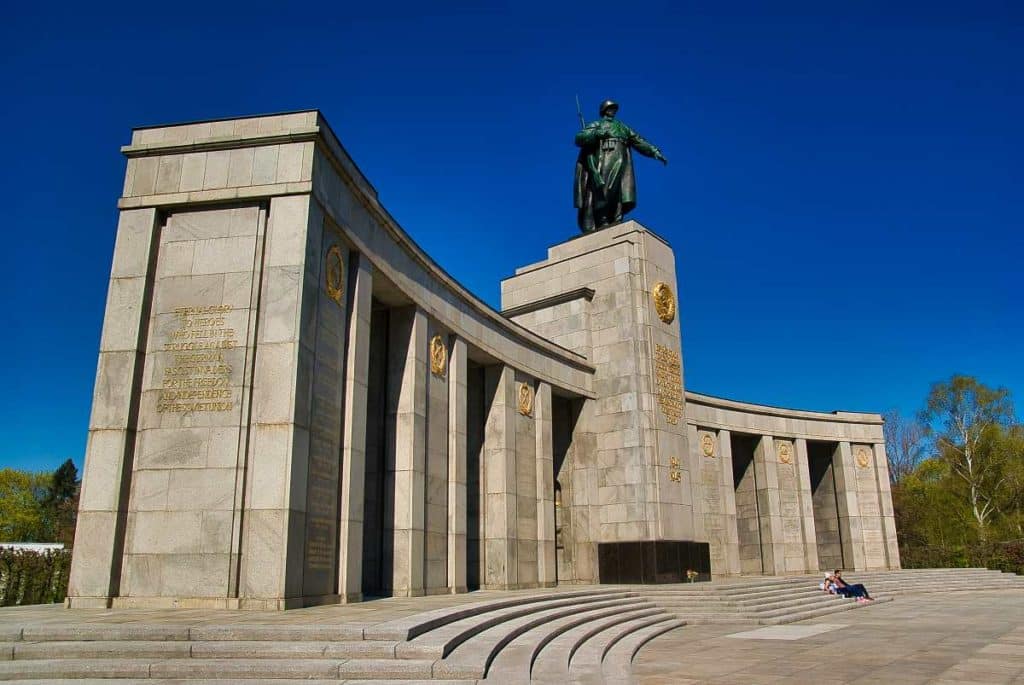
The memorial during the Cold War
What was not considered when the site was chosen in 1945, or was hardly foreseeable in detail, was that the memorial was located in the British sector after Berlin was divided into the four occupation zones. After the Wall was built, the memorial became a Soviet enclave on West Berlin soil. Particularly disconcerting, especially for Western tourists, was the presence of Red Army Guards who guarded the memorial around the clock. For West German and West Berlin opponents and enemies of the Soviet Union, the memorial was naturally a thorn in the side. However, its location and preservation was enshrined in the city’s four-power status.
The attack by a neo-Nazi, who shot and seriously injured one of the guards in November 1970, led to increased security measures. The area was cordoned off with a metal fence and the gravesite was also guarded by the British military. Until 1990, the day of the German surrender or victory in the “Great Patriotic War” was celebrated every year with great military fanfare. On December 22, 1990, the last Soviet guard of honor in the Tiergarten ended and the state of Berlin took over responsibility. Today, the memorial in Tiergarten is open around the clock.
The Soviet memorial in Treptower Park
The immense monumentality, the strict axial symmetry and the colossal yet detailed statues of soldiers at the memorial in Treptower Park still impress first-time visitors today. The complex extends over 90,000 m² and is by far the largest military memorial in Germany. At the same time, around 7000 fallen Red Army soldiers were buried here.
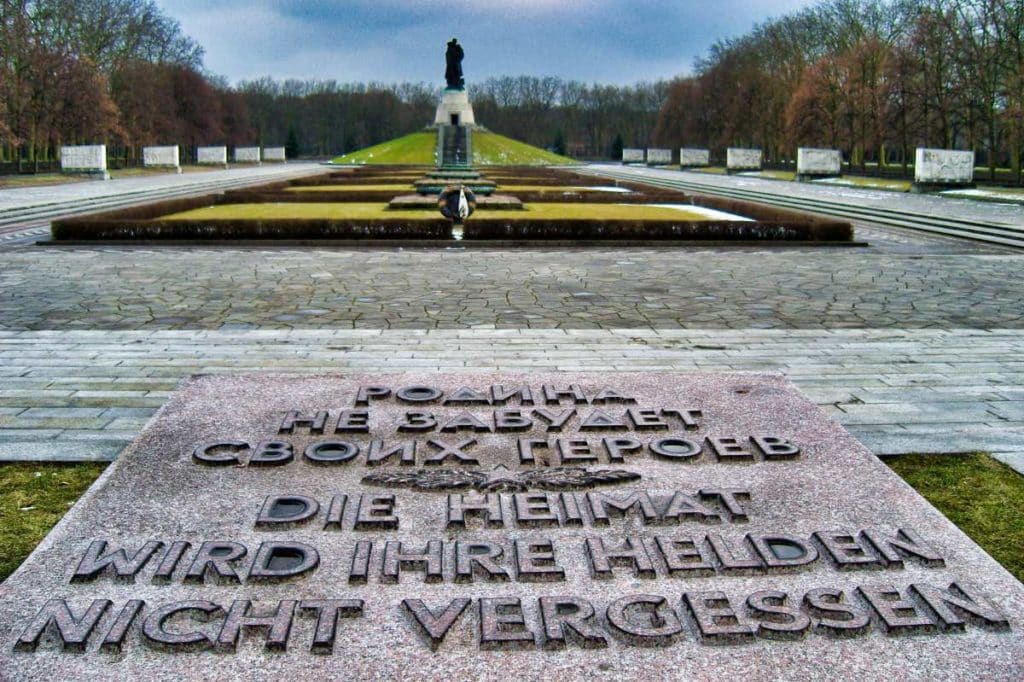
History of the Treptower Park memorial
In contrast to its counterpart in Tiergarten, which was built immediately after the end of the war, the Soviets took more time to build in Treptower Park – which was presumably necessary due to the planned size. More than 40 designs were submitted by various artists and architects in response to a call for tenders by the Soviet military administration. In the end, the concept of a four-member collective consisting of the architect Yakov Belopolsky, the painter Alexander Gorpenko, the sculptor Yevgeny Vuchetich and the engineer Sarra Walerius was selected.
Construction work in Treptower Park began in June 1946. In order to keep the motivation of the more than 1,200 construction workers high in the tight schedule, they and their families were provided with special food rations. The building materials, especially granite, limestone and marble, were procured from villas and government buildings destroyed during the war and in some cases from stone depots that had been set up by the National Socialists for their planned magnificent buildings after the end of the war. The heavy stone slabs were transported directly to their place of use on a narrow-gauge railroad that had been built on the construction site.
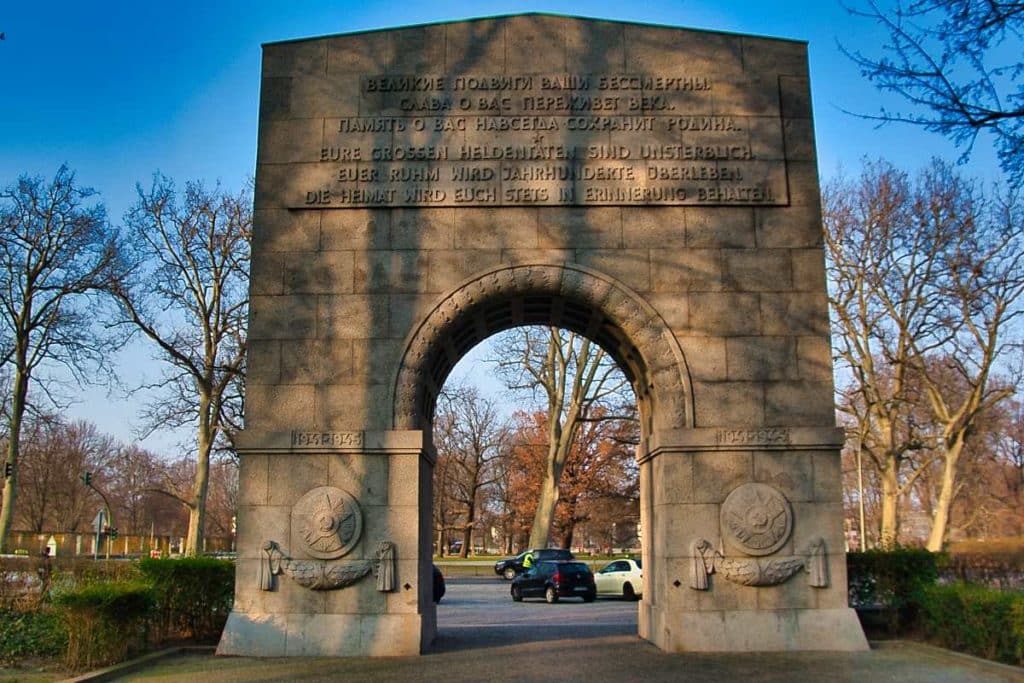
Structure and layout of the system
The memorial has two entrances: from the north via “Puschkinallee” and from the south via “Am Treptower Park”. On both sides, a triumphal arch forms the entrance portal, on the head of which the “Eternal Glory of Heroes” is commemorated in Russian and German. The two entrance axes meet at the monument to “Mother Homeland”, a mother mourning her fallen son. The wide, approx. 100-metre-long main axis begins directly in front of the sculpture and leads slightly uphill into the memorial, flanked on both sides by weeping birch trees.
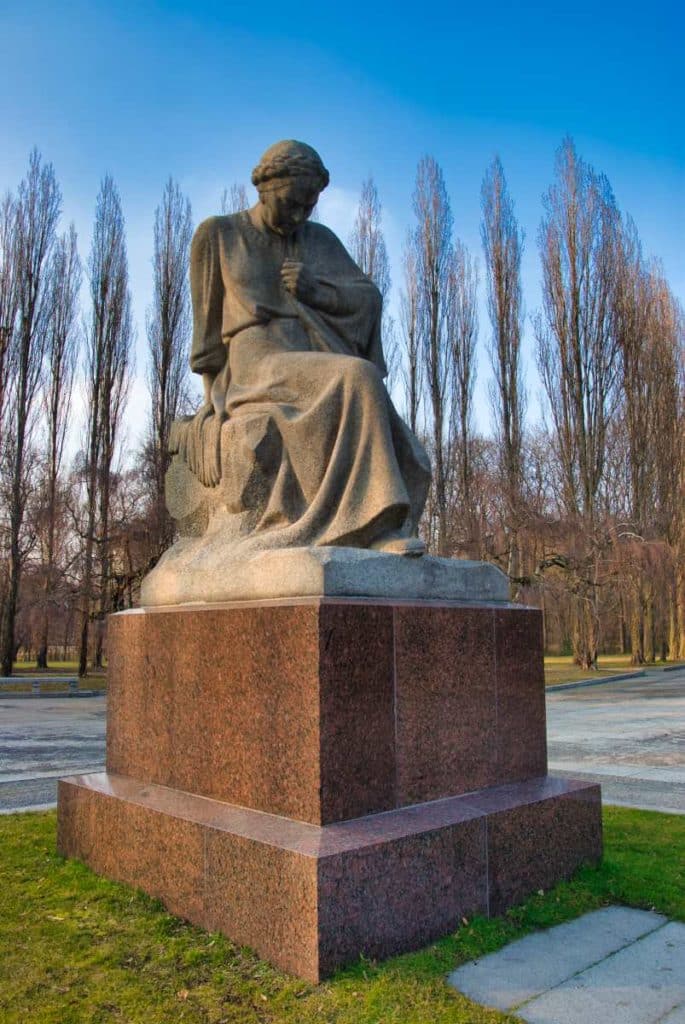
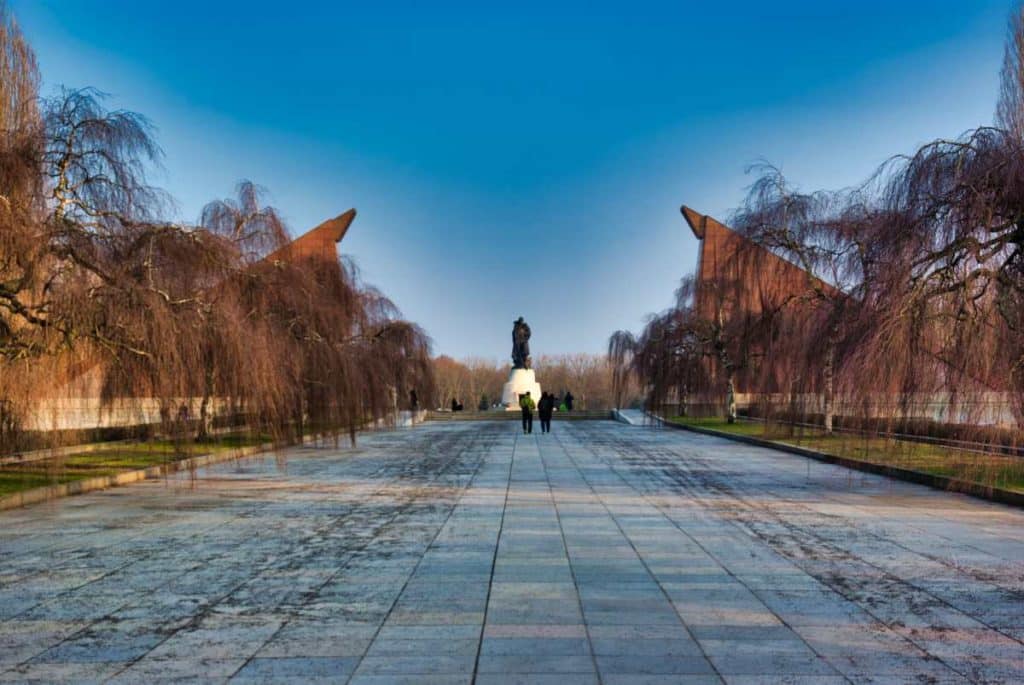
Two strictly structured flag pylons made of red granite then form the gateway to the memorial grove in Treptower Park, the center of the entire complex. Two bronze soldiers kneel beneath the granite flags. With their heads bowed in deep mourning, they hold their steel helmets in their left hand and the submachine gun resting on the buttstock in their right. The statues, a young and an older Red Army soldier, representing the intergenerational fight against fascism, weigh around 40 tons each.
From the raised terrace, visitors now have a view of five square burial plots arranged in a row, 16 sarcophagi placed in rows of eight to the left and right of the burial plots. Sculptures on the sarcophagi depict the various phases of the Great Patriotic War, ranging from the German attack and partisan warfare to victory and mourning for the sons of the Soviet Union. Quotes from Stalin are immortalized on the sides in gold lettering, manifesting the Soviet people’s strong spirit of struggle and resistance:
The heroic defenders of Moscow and Tula, of Odessa and Sevastopol, of Leningrad and Stalingrad gave examples of boundless bravery, iron discipline, steadfastness and the art of victory. Our entire Red Army is modeled on these heroes.
Inscription on sarcophagus no. 5; on the northern side the quotations are in Russian, while the German translations can be found on the sarcophagi on the southern side

The liberation warrior
The monument to the Soviet soldier is enthroned at the south-eastern end of the Treptower Park complex: the bronze warrior of liberation in Treptower Park rises 30 meters into the Berlin sky. It represents the decidedly imposing final point of the entire ensemble, to which everything ultimately boils down in perfect architectural dramaturgy. The actual monument rests on an almost 10 meter high mound of earth, the Kurgan. It takes its name from the conical burial mounds that have been built since the Neolithic period, particularly in the Slavic-speaking area. The Kurgan in Treptower Park is therefore part of a long historical tradition, which was certainly the intention of its builders.
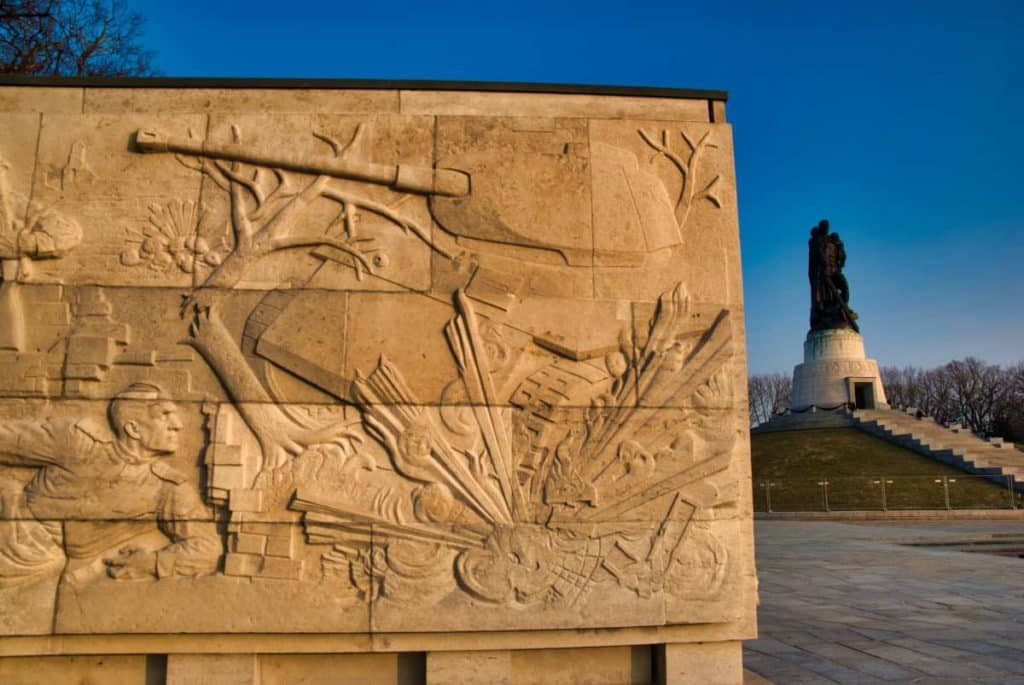
The remains of 200 Red Army soldiers are buried in the mound itself. The liberation warrior rises above a mausoleum clad in white limestone. In his right hand he holds the sword lowered to the ground, while in his left he holds a little girl who is snuggled up close to him. A broken swastika sticks out from under his soldier’s boots. The bronze sculpture forms the western end of a “Soviet monument trinity”: the steel was forged in Magnitogorsk, on the Urals, in Stalingrad, today’s Volgograd, “Mother Homeland” raises her sword against the invaders and in Berlin the warrior lowers his sword, as the battles have ended victoriously.
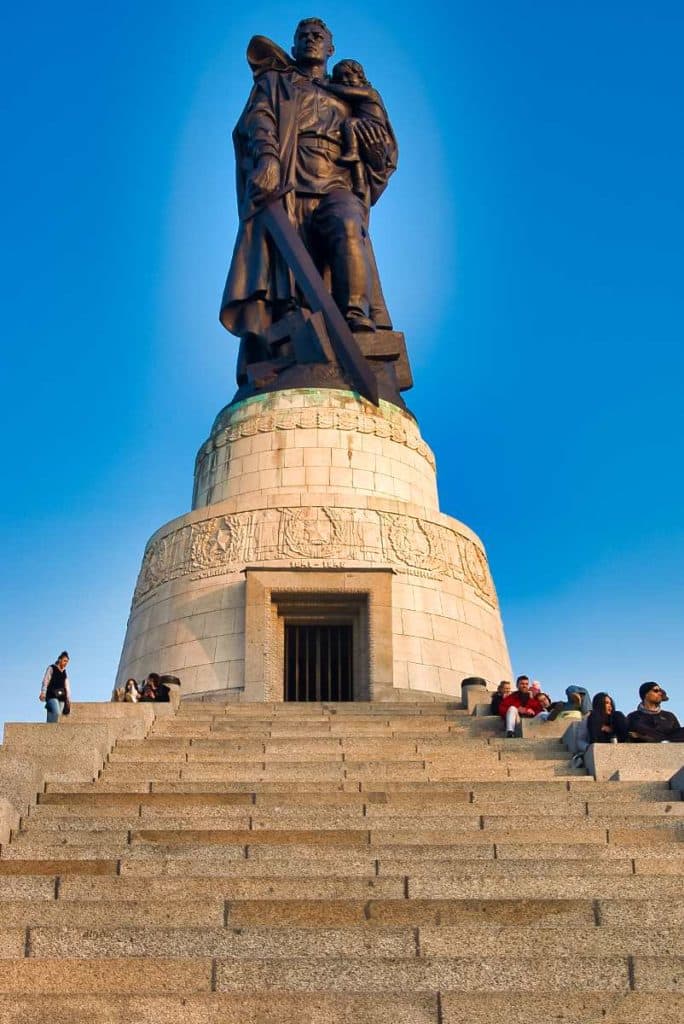
The casting of the 70-ton sculpture for Treptower Park was so complex that no German foundry could be found in the post-war period to take on the job. The preliminary model was therefore cut into several horizontal slices, transported by train to Leningrad and cast there in the corresponding individual parts. The bronze parts returned to Berlin in mid-April 1949 and were assembled – like a gigantic Lego set. This was just in time to meet the planned opening date: on May 8, 1949, the fourth anniversary of the German capitulation, the ceremonial opening took place in the presence of Soviet generals and (East) German dignitaries.
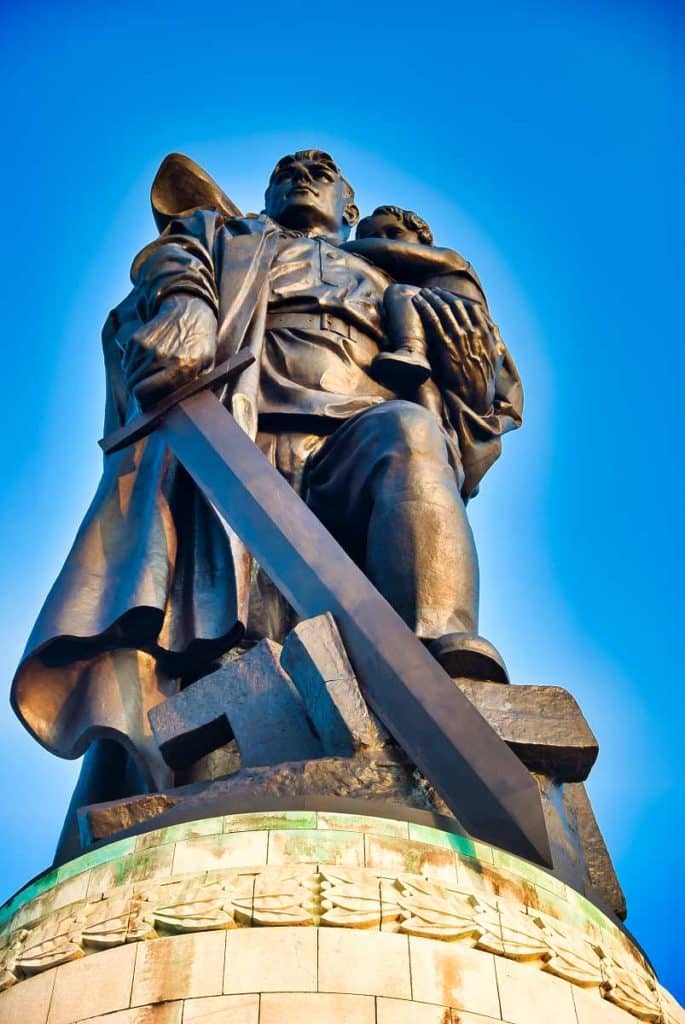
Symbol of victory over fascism and a turning point in history
In the decades that followed, countless manifestations of the “unbreakable” friendship between the GDR and the Soviet Union took place on the grounds in Treptower Park. Every year, May 9 was jointly celebrated as the day of victory over Hitler fascism. The last official German-Russian ceremony at government level was particularly symbolic: on August 31, 1994, Russian and Bundeswehr soldiers jointly honored their fallen comrades and the heads of state Boris Yeltsin and Helmut Kohl gave unctuous speeches.

This ceremony marked the end of the Soviet military presence on German soil after almost 50 years and the last contingents of Red Army troops left for the east. Today, the Soviet memorial in Treptower Park is open around the clock.
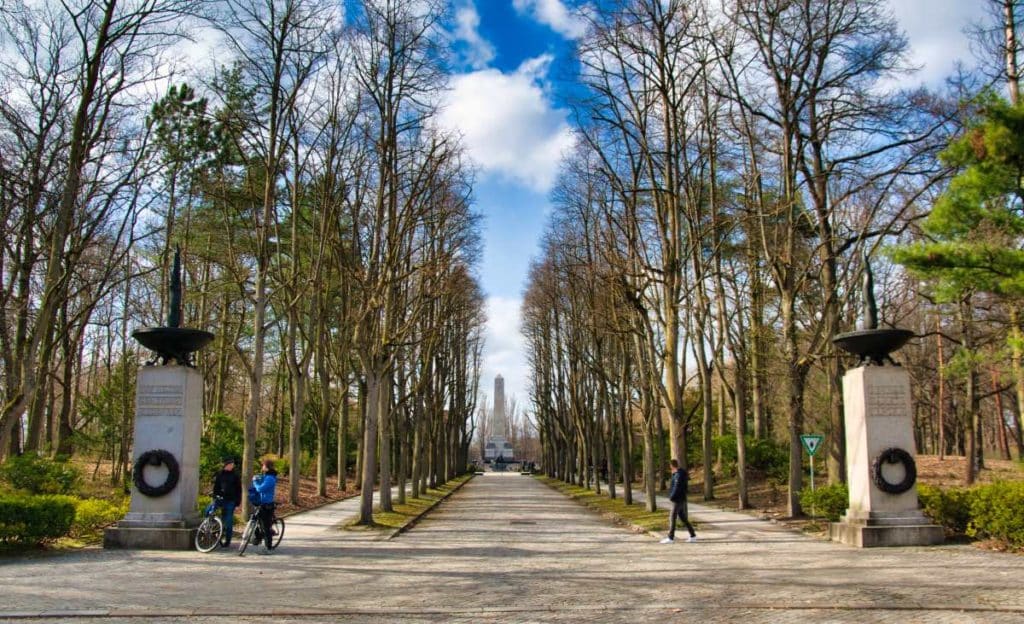
The Soviet memorial in Schönholzer Heide
The third memorial we visit is also in the same chronological location: it was opened in November 1949 after two years of construction. Its architectural design is similar to its counterpart in Treptower Park, but it is only a third of the size. Over 13,000 Russians were buried on the almost 30,000 square meters. The majority of the victims died in the final battles for Berlin in April 1945. During the war, Schönholzer Heide was home to a camp for Soviet prisoners of war and forced laborers, where the blood toll, as in practically all German camps, was extremely high.

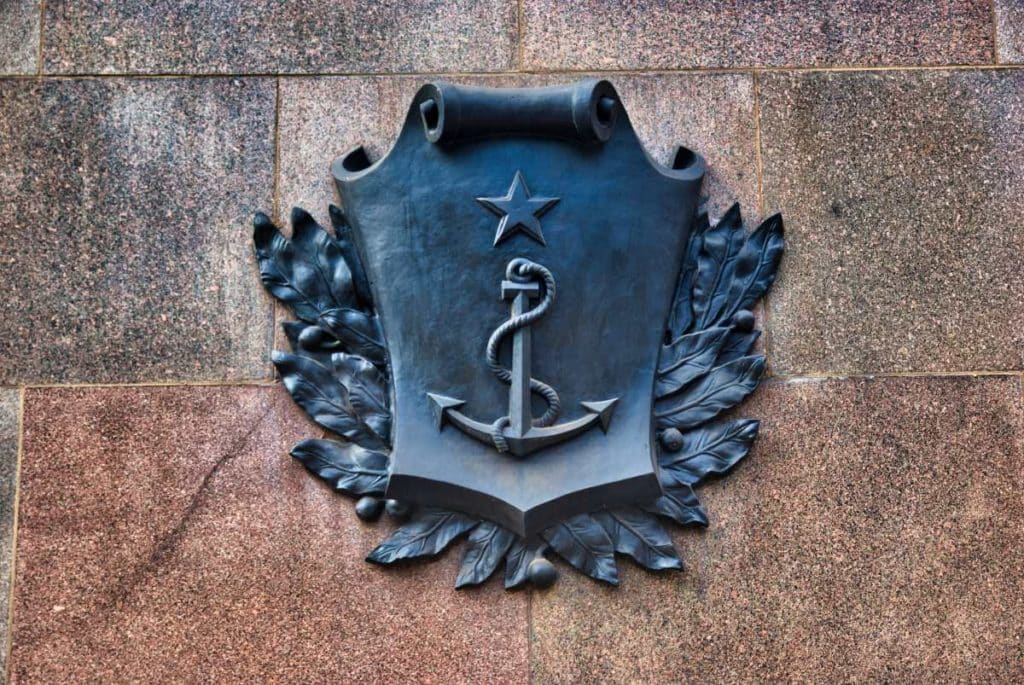
The Soviet victims of the brutal camp regime were reburied after the end of the war and were also given their final resting place within the walls of the memorial. Schönholzer Heide is therefore the only Soviet memorial in Berlin that pays tribute to both those who died directly in the war and those who perished in captivity. In view of Stalin’s distrust of Red Army soldiers who had fallen alive into the hands of the enemy, this joint commemoration is all the more unusual. For the “Generalissimo”, captured Red Army soldiers were either cowards or – even worse – traitors to the Red Army.

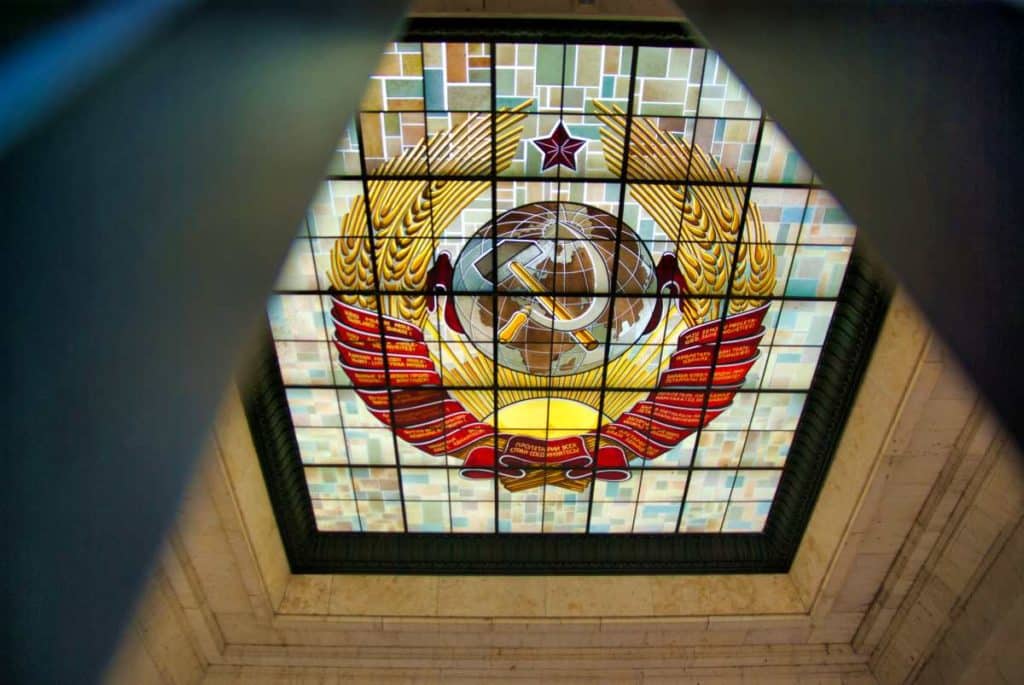
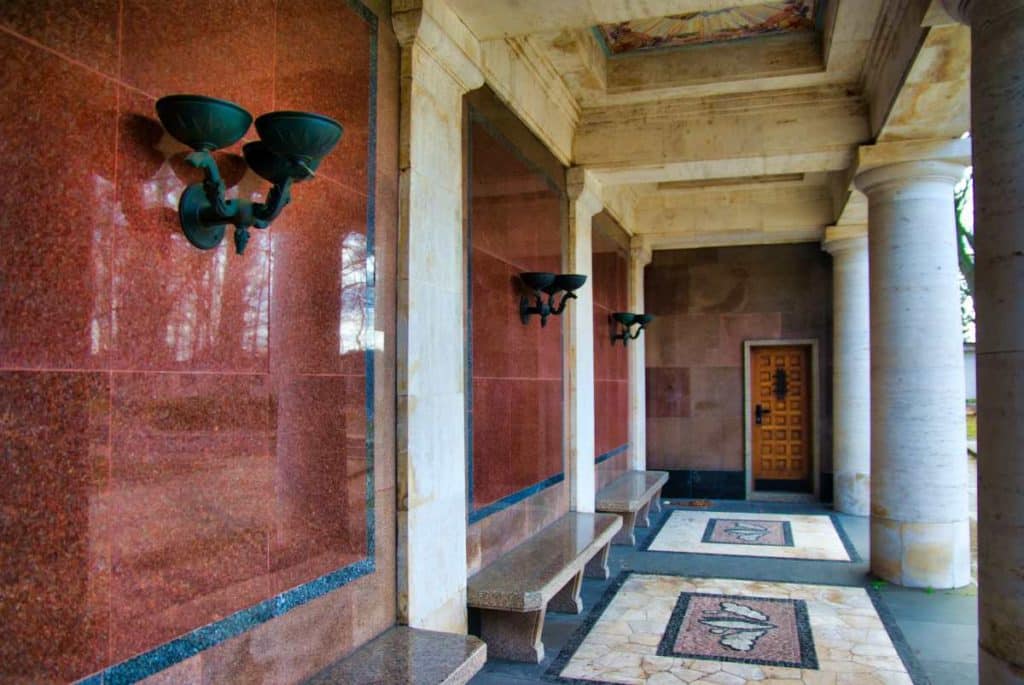
Stalinist monumental architecture
Visitors approach the grounds from the south along an avenue lined with magnificent lime trees. The avenue is flanked by two honorary columns on which a stylized eternal flame blazes. Behind a metal fence, the large grove of honor opens up, preceded by an imposing entrance portal made of red granite. Large relief sculptures bear witness to war, misery, death and ultimately victory. Various insignia attached to the portal bear witness to the contributions and sacrifices of the various branches of the Red Army.
If you follow the strictly axial design of the complex, for which the architects K.A. Solovyov, M.D. Belaventsev, V.D. Korolyov and the sculptor I.G. Perschudchev were responsible, further north, you approach the 16 burial chambers, in which almost 1,200 soldiers are buried. Directly on the outer walls of the area you will discover another large number of burial plots marked with name plaques. In total, however, more than 75% of those buried here are unknown by name.
The dramatic highlight of the complex is a gigantic obelisk over 33 meters high, in the foundation of which higher-ranking officers are buried, each honoured with an individual epitaph. In front of the obelisk, “Mother Homeland” mourns her fallen son, who lies in state before her.
On the northern perimeter wall, directly behind the obelisk, a massive Soviet star and a plaque commemorate the camp victims.

The complex is in excellent overall condition, having been refurbished and renovated at a cost of over 10 million euros between 2010 and 2013. In contrast to the much better-known memorials in Tiergarten and Treptower Park, only a few visitors find their way to Schönholzer Heide. This means that you can always find a quiet spot here to contemplate war, peace and transience. However, you should keep an eye on the opening hours (April-September 7-19, October-March 8-16).

Book tip
No products found.
This beautifully illustrated book provides a comprehensive overview of all Soviet memorials in East and West Germany and is a must for anyone interested in this chapter of history.
How did you like the article about Soviet memorials in Berlin, Treptower Park, the memorial in Tiergarten and the memorial in Schönholzer Heide? Write us a comment! You can also follow wildeast on Facebook or Pinterest to keep up to date with the latest articles.
Still haven’t had enough of Berlin? Click here for our article about the most exciting GDR buildings in East Berlin. And if you click here, you’ll get to our article about Karl-Marx-Allee. Fans of Art Nouveau should definitely not miss this article and anyone interested in Jewish Berlin will find what they are looking for here.


